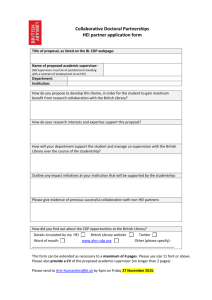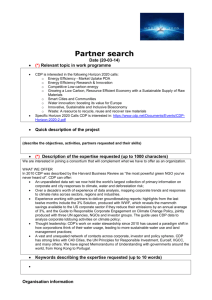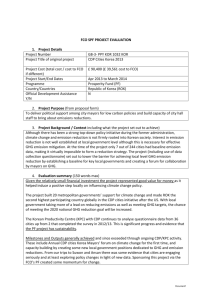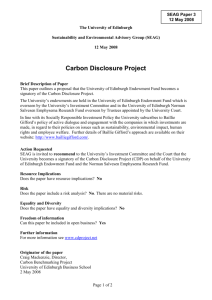CCNA 2 Chapter 4
advertisement
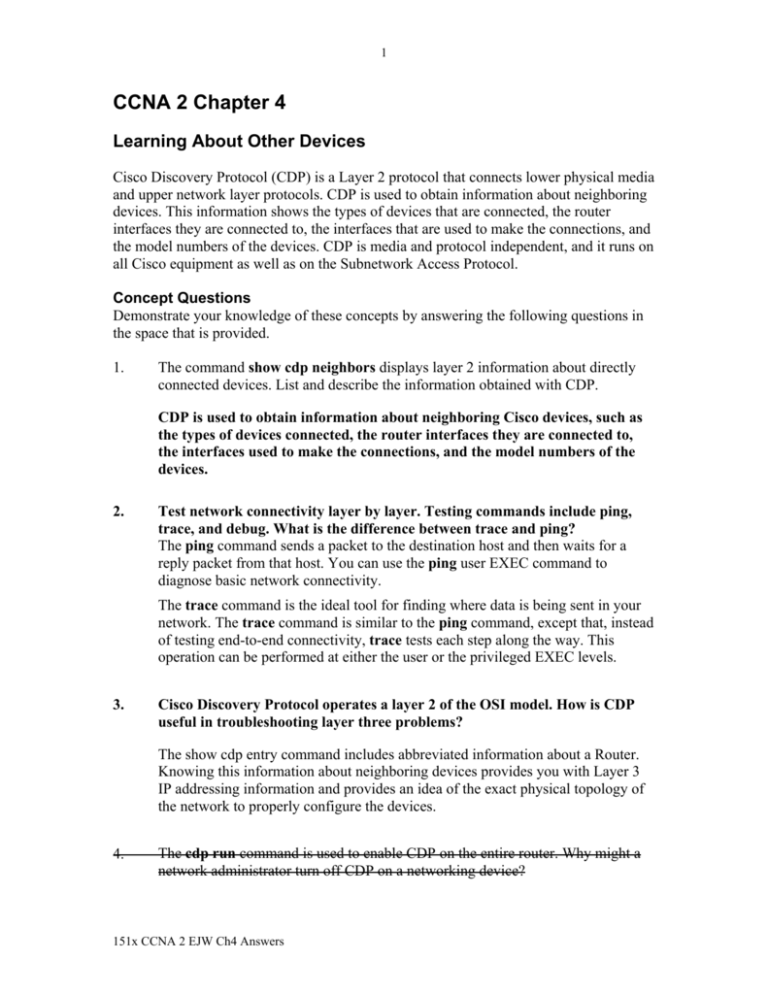
1 CCNA 2 Chapter 4 Learning About Other Devices Cisco Discovery Protocol (CDP) is a Layer 2 protocol that connects lower physical media and upper network layer protocols. CDP is used to obtain information about neighboring devices. This information shows the types of devices that are connected, the router interfaces they are connected to, the interfaces that are used to make the connections, and the model numbers of the devices. CDP is media and protocol independent, and it runs on all Cisco equipment as well as on the Subnetwork Access Protocol. Concept Questions Demonstrate your knowledge of these concepts by answering the following questions in the space that is provided. 1. The command show cdp neighbors displays layer 2 information about directly connected devices. List and describe the information obtained with CDP. CDP is used to obtain information about neighboring Cisco devices, such as the types of devices connected, the router interfaces they are connected to, the interfaces used to make the connections, and the model numbers of the devices. 2. Test network connectivity layer by layer. Testing commands include ping, trace, and debug. What is the difference between trace and ping? The ping command sends a packet to the destination host and then waits for a reply packet from that host. You can use the ping user EXEC command to diagnose basic network connectivity. The trace command is the ideal tool for finding where data is being sent in your network. The trace command is similar to the ping command, except that, instead of testing end-to-end connectivity, trace tests each step along the way. This operation can be performed at either the user or the privileged EXEC levels. 3. Cisco Discovery Protocol operates a layer 2 of the OSI model. How is CDP useful in troubleshooting layer three problems? The show cdp entry command includes abbreviated information about a Router. Knowing this information about neighboring devices provides you with Layer 3 IP addressing information and provides an idea of the exact physical topology of the network to properly configure the devices. 4. The cdp run command is used to enable CDP on the entire router. Why might a network administrator turn off CDP on a networking device? 151x CCNA 2 EJW Ch4 Answers 2 Editor’s Note: This question and answer is addressed in the fifth concept question. 5. The command cdp enble is used to enable CDP on an interface. Why might a network administrator turn off CDP on an interface? Some devices do not support CDP. Other examples include particular interfaces that might not have CDP enabled for security purposes. 6. Telnet is used to test layer seven of the OSI model. Telnet is used to log in and issue commands to a remote router. Why would a network administrator want to suspend and then resume a Telnet session to a router? The telnet command is the most complete test mechanism available to verify the application layer software between source and destination. Vocabulary Exercise Define the following terms as completely as you can. Use the online curriculum or CCNA 2 Chapter 4 from the Cisco Networking Academy Program CCNA 1 and 2 Companion Guide, Revised Third Edition, for help. CDP (Cisco Discovery Protocol)--Media- and protocol-independent device-discovery protocol that runs on all Cisco-manufactured equipment including routers, access servers, bridges, and switches. Using CDP, a device can advertise its existence to other devices and receive information about other devices on the same LAN or on the remote side of a WAN. Runs on all media that support SNAP, including LANs, Frame Relay, and ATM media. CDP enable-- Enables CDP on an interface. CDP run-- Enables CDP globally on the router. CDP timers-- Specifies how often Cisco IOS Software sends CDP updates. Interface--1) Connection between two systems or devices. 2) In routing terminology, a network connection. 3) In telephony, a shared boundary defined by common physical interconnection characteristics, signal characteristics, and meanings of interchanged signals. 4) The boundary between adjacent layers of the OSI model. ping--Command that uses the ICMP protocol to verify the hardware connection and the logical address of the network layer. This is a very basic testing mechanism. resume--This will resume the connection to the most recently suspended Telnet connection requiring a connection ID. 151x CCNA 2 EJW Ch4 Answers 3 Telnet--Command used to verify the application layer software between source and destination stations. It is used for remote terminal connection, enabling users to log into remote systems and use resources as if they were connected to a local system. trace--Command that uses Time-To-Live (TTL) values to generate messages from each router used along the path. This is very powerful in its capability to locate failures in the path from the source to the destination. Focus Questions 1. Briefly describe what the show cdp neighbors command can tell you about a network. The show cdp neighbors command can be used to obtain the following information: • Device ID • Address • Port ID • Capabilities • Version • Platform • IP Network Prefix • VTP Management Domain Name (CDPv2 only) • Native VLAN (CDPv2 only) • Full/Half-Duplex (CDPv2 only) 2. Briefly describe the three major routed protocols that CDP provides information. TCP/IP, Novell IPX, Appletalk 3. Using the OSI model and the commands telnet, ping, trace, show ip route, and show interface, describe the basic testing of a network. The basic testing of a network should proceed from Layer 7 (using telnet to access various routers), to Layer 3 (using ping, trace, and show ip route to learn logical address information about the network), and then to Layers 3, 2, and 1 (using show interface to learn about specific port configurations and whether specific links are alive), and then on to Layer 1 (specific medium tests). 4. Briefly describe what the show cdp command can tell you about a router Displays information about CDP update packets. 151x CCNA 2 EJW Ch4 Answers 4 5. Briefly describe the function of the cdp timers command. Specifies how often Cisco IOS Software sends CDP updates. 6. Briefly describe the difference between the resume command or pressing the Enter key during a suspended Telnet session. The resume command will resume the connection to the most recently suspended Telnet connection requiring a connection ID. 7. Briefly why Telnet is an excellent network-troubleshooting tool. The telnet command is the most complete test mechanism available to verify the application layer software between source and destination. CCNA Exam Review Questions The following questions help you review for the CCNA exam. Answers appear in Appendix B, "CCNA 1 and 2 Exam Review Questions Answer Key." 1. Which one of the following is a function of CDP? A. It provides a way to use an echo to evaluate the path-to-host reliability. B. It provides a way to determine whether a routing table entry exists. C. It provides a way to see the current running configuration on the local router. D. It provides a way to access summaries of configurations on directly connected devices. 2. Which of the following is a characteristic of CDP? A. It runs over OSI Layer 3. B. It allows CDP devices that support different network layer protocols to learn about each other. C. It obtains information about neighboring devices only if the administrator enters commands. D. It obtains information only about devices that are running TCP/IP. 3. What steps does the network administrator have to take to make CDP run at system startup? A. Type cdp enable at the first router prompt. B. Type cdp enable at the first privilege EXEC router prompt. C. CDP runs automatically at startup. D. Type cdp enable at any prompt and then save the config file. 4. Which of the following is a function of the show cdp command? A. It displays information about any CDP-enabled router on the network. 151x CCNA 2 EJW Ch4 Answers 5 B. C. D. It displays information on a console that is connected to any node in the network. It helps evaluate delays over network paths and path-to-host reliability. It identifies neighboring routers' host names and IP addresses. 5. Which of the following is not provided by the CDP show command to tell about neighbor routers? A. Processes list, with information about the active processes B. Port identifier, such as Ethernet0, Serial1, and so forth C. The device's hardware platform D. Address list, with addresses for supported protocols 6. Which of the following is a function of the cdp enable command? A. It boots up the Cisco IOS software and implements diagnostic testing. B. It displays values of the CDP timers. C. It begins CDP's dynamic discovery function on the router's interfaces. D. It discards expired hold-time values. 7. Which of the following is not a function of the show cdp interface command? A. It displays the values of the CDP timers. B. It displays the reasons for system reboot. C. It displays the interface status. D. It displays the encapsulation that CDP uses. 8. Which of the following is a function of the show cdp entry [device_name] command? A. It establishes a connection to a remote router. B. It displays the cached CDP entry for every directly connected CDP router. C. It enables an administrator to see the IP addresses of the targeted router. D. It displays version information about the network protocols that are running on the router. 9. Which of the following is not a function of the show cdp entry [device_name] command? A. It displays the cached CDP entry for every directly connected CDP router. B. It displays all Layer 3 addresses that are present on the router. C. It displays how long ago the CDP frame arrived from the router. D. It displays version information about the router. 10. Which of the following is a function of the show cdp neighbors command? A. It displays the device capability code of remote routers. B. It displays the path-to-host reliability of a network connection. C. It displays the encapsulation of the protocols that neighbor routers use. D. It displays the neighbor's remote port type and number. 151x CCNA 2 EJW Ch4 Answers 6 11. Which of the following is not a function of the show cdp neighbors command? A. It displays the cached CDP entry for every directly connected CDP router. B. It displays the CDP updates that are received on any network router. C. It displays information like that from show cdp entry when show cdp neighbors detail is used. D. It displays neighbor device IDs. 12. Why would you use the show cdp neighbors command? A. To get a snapshot view of the routers in the network B. To get an overview of the routers that are directly connected to you C. To get the IP addresses for neighboring routers D. To build a routing table for all routers that are in the network neighborhood 13. Which of the following is a feature of Telnet router operations? A. Telnet is typically used to connect a router to neighbor routers. B. A router can have only one incoming Telnet session at a time. C. A Telnet session can be suspended and then resumed. D. To initiate a Telnet session, you must know the name of the host. 14. Which of the following layer 3 protocols does CDP not provide information? A. Appletalk B. IP C. IPX D. SNMP 15. Which of the following is a feature of CDP A. Obtains information about only directly connected Cisco devices B. Runs on all Cisco equipment C. Operates at layer two of the OSI model. D. Media and protocol dependent 16. Which of the following is not a feature of Ping A. Used to test the application layer of the OSI model B. Uses echo and echo reply C. Verifies reachability D. Very basic testing tool 151x CCNA 2 EJW Ch4 Answers 7 17. What is the default log out time for a Telnet session to a router? A. 300 seconds B. 600 seconds 900 seconds C. D. Never Editor’s Note: This question was included in error. The answer to this question is not covered in the CCNA 1 and 2 Companion Guide, Revised Third Edition. 18. What is the key sequence to suspend a Telnet session? A. Ctrl-B B. Ctrl-Shift C. Ctrl-Shift-6, then x D. Ctrl-Alt-Shift-Delete 151x CCNA 2 EJW Ch4 Answers

